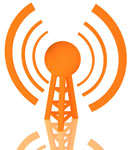
During 2011, nineteen million miles of fiber optic cable were installed in the United States, according to CRU Group, a global research firm. That means all the fiber that was laid in the U.S. last year could be wrapped around the equator 763 times. It was the largest installation since the boom year of 2000. And the reason has a lot to do with wireless services.
When using 4G on that new mobile phone, your connection is mostly wired. It is wireless from the tower to your hand -- a distance of anywhere from a few thousand feet to a few miles. But probably for hundreds of miles, that connection is on fiber-optic lines.
Before a tower can offer 4G services, it needs a fiber cable, and that is driving a boom in connecting towers. In our recent case studies on Chattanooga, Lafayette, and Bristol, we noted that both Bristol and Chattanooga have connected towers with fiber optics for 4G wireless service from major carriers.
The boom in 2000 was famously short sighted, in part because it was almost all located in major corridors with other fiber cables -- no one was making the last mile connections to residents and local businesses.
Regardless of how much fiber optic lays out there unused, we need more -- but in the right places. A Wall Street Journal article by Anton Troianovski recently discussed the boom in new fiber investment, quoting Hunter Newby, Chief Executive of Allied Fiber:
"The notion there is a fiber glut is not true," Mr. Newby says, arguing that much of the fiber-optic cable that is available is simply not in the right place - not at suburban office parks and cellphone towers that need it.
Allied Fiber is building its own network between New York and Chicago with the intention of offering alternatives to established carriers, including Verizon and AT&T. Newby and Allied believe that other Internet companies, wireless carriers, hospitals, and possible anchor institutions will want the choices they don't have now. By extending their network to the right places, Allied sees opportunity.
These companies are cashing in on a major market failure. Unfortunately, they are likely to just pick the low-hanging fruit, serving the major community anchors but not having a business model to serve the whole community. Without the anchors, even the community itself will have trouble building a network that will cash-flow, to say nothing of the impossibility of other private companies doing it.
Communities should be building their own networks to connect their community anchors, regardless of whether they ever plan to connect a resident or local business. They can always change their mind in the future and in the meantime, the schools and libraries can access the highest capacity networks at a fraction of the price charged by private sector providers.
Regardless, the fiber boom is presently driving jobs across America as wired investment secretly powers the wireless that most are fixated upon. To accompany Anton's story, the Wall Street Journal released this video about fiber investment in Missouri:





